Arts & Culture
About Andrew Cusack
 Writer, web designer, etc.; born in New York; educated in Argentina, Scotland, and South Africa; now based in London.
Writer, web designer, etc.; born in New York; educated in Argentina, Scotland, and South Africa; now based in London. read more
News
Blogs
Reviews & Periodicals
Arts & Design
World
France
Mitteleuropa
Knickerbockers
Argentina
The Levant
Africa
Cape of Good Hope
Netherlands
Scandinavia
Québec
India
Muscovy
Germany
Academica
The Church in China
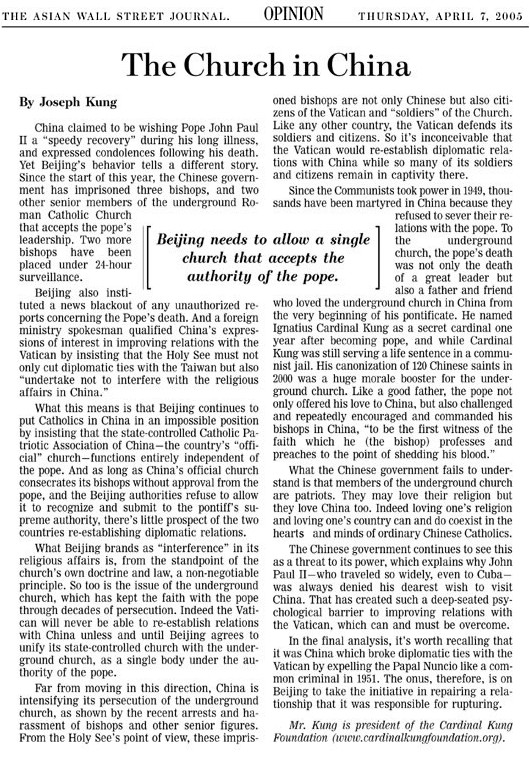
C.f. the Cardinal Kung Foundation.
Back in the Day
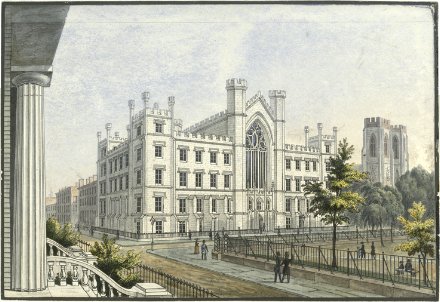
The University of the City of New York (now New York University),
Washington Square, 1850.
‘Mitre Schmitre’: A Brief Dissection
Nothing is quite as much fun as a good old debate in the press. Alas, the Saint, true to form, published a somewhat slapdash and second-rate response (see post below) to what I thought was a pretty decent, albeit somewhat light-hearted, attack (see the Mitre, February 15, 2005, pp. 1-3). Well, herein follows a very brief highlight of portions of Mr. Hendele’s retort.
“Most of you probably haven’t read it – or heard of it – but what is important is that it continues to provide students with a voice.”
Judging from the usual content of the Saint, we should very much hope that their target audience has not heard of us, let alone read us. We are a quality newspaper, we are not a tool for entertaining the masses.
“What is important is that it continues to provide fair and unbiased coverage of things which matter most to students.”
Here, I must report an innacuracy. Though the Mitre is fair, we are far from unbiased. In fact, I am happy to report we have all the best biases.
“In a ‘recently’ – it only comes out once a month – published editorial from the Mitre of February of this year, the paper claimed The Saint has adopted a patronising, smug tone toward Christians, evangelicals and Catholics, and that this is indicative of our ‘intellectual backwardness.’ First of all, I do not see how one’s tone can be construed as an indicator of their intellect.”
I would advise the author to keep trying; perhaps someday he will gain just such an ability.
“Further, all of the articles written about Christians this year were authored by a Catholic, me, and have been aimed at the bigots who travelled great distances in an attempt to silence students’ in their exercise of the inalienable right to expression.”
Oh, the author is Catholic! Always good to have a fellow Catholic in the student press. Strange that he would defend a supremely blasphemous and perverted play as the ‘exercise of the inalienable right to expression’, but at least the author is Catholic, right?
“Secondly, how dare a paper so obviously enamored with the intricacies of Mother Church and the brainwashing dogma prescribed by it attack The Saint for being intellectually backward.”
Wait, I thought he said he was Catholic? Labelling the dogma proclaimed by Christ’s Church as “brainwashing” and insinuating that Catholicism (which I’m sure the author will recall is responsible for the preservation and maintanence of Western civilization not to mention the foundation of the University of St Andrews and every medieval university in Europe) is actually “intellectually backward” are not things that Catholics are wont to do. Perhaps the author meant to write “former Catholic” or “ex-Catholic” or the trendy “recovering Catholic” or the slightly more neutral “was raised Catholic” which would imply the disassociation from the Church so blatant in the author’s tone.
I also, perchance, wonder what Augustine and Aquinas would think when, upon reading the Saint, they discovered – quel horreur! – that James Hendele has implied that is they, the members of the greatest intellectual tradition the world has ever known, who are intellectually backward, instead of the mindless drones who regurgitate the spirit of the age fed up by the Guardian, New Statesman and other outlets of the secularist media and culture.
“Furthermore, the only other articles written about the University’s Christians this year have been in regards to their annoying, yet undeniably plucky, insistence on inviting ‘academics’ to speak on the merits of creationism.”
First Mr. Hendele said he wrote all the articles about Christians this year, now he says that there are others. Besides, we did not attack the Saint for having a smug and patronising tone for just this year; it has existed longer than that.
“The Saint has asked the Christian Union in a number of instances to contribute pieces reflecting their stances on issues of national importance and has not once heard a reply. Pot + Kettle = Black, you do the math.”
The Mitre is in absolutely no way associated with the (evangelical) Christian Union and never shall. The Christian Union often propagates the opposite strain of anti-intellectualism to that exhibited in the Saint.
“In that same article of February of this year, the Mitre not only goes on to quote our current, supremely ineffectual and apathetic rector, as saying that he believes The Saint has let its standards slip, but also accuses the paper of printing an excess of copies in order to somehow defraud would-be advertisers out of money. Any article based on the words of Clement Freud, a man more concerned with the sound of his own voice, should be taken with a pinch of salt. His recent contradictory statements on the problems The Saint were facing is testament to that. Furthermore, I do not see how printing extra copies and not selling them would in any way entice businesses to advertise. In fact the reason we print so many copies is because we must print a minimum of 1,000 and every thousand copies above that number costs only £3. It would do the Mitre well to get its facts straight before it starts pointing fingers at out ‘faulty accountants.'”
The remarks against Clement Freud are not worth refuting. Putting quotation marks around “faulty accountants” in my mind implies that such was a term used in either the Mitre article or commentary piece. In fact, the phrase is in neither the article nor the opinion piece. A tad misleading, but easily forgiven.
Mitre Schmitre
The Uni’s other newspaper ought to get its facts straight
(Published in the Saint, Thursday 5 May 2005)
by JAMES HENDELE
Here’s something I bet you didn’t know: our university has not only one, but two student newspapers. Well, more like one student newspaper and one student evangelical handout. Now I am not one to lambaste members of my own literary community, to accuse and name call and slander those I consider my fellow scholars and thinkers and journalists. I admire their effort. To start a student newspaper from scrap and turn it into a publication that can rightfully claim to be St Andrews’ most religious monthly takes determination, smarts and a dose of class.
Most of you probably haven’t read it – or heard of it – but what is important is that it continues to provide students with a voice. A voice which can be heard all the way from North Street in the north to South Street in the south. What is important is that it continues to provide fair and unbiased coverage of things which matter most to students: the latest Vatican news, the status of the recently formed St Andrews pro-life society, a definitive guide to the town’s best martini, and in depth coverage of Pope-watch ‘05. What is important is that it continues to assail those who would hinder students in their quest to know the specific details of last week’s debate. Here here, Mitre, here here.
I do not really think that anyone could possibly argue that this town is too small for two papers or that it is too liberal for a conservative voice. Quite the contrary – this student body has long been in need of a paper dedicated to voicing the concerns of those among us with a political or religious persuasion which would cause them to vote Tory and rest on the Sabbath. What bothers me is the way in which this University’s second paper has, at many instances, rebuked the editorial team of The Saint when it is guilty of the same sins it claims to reject.
In a “recently” – it only comes out once a month – published editorial from the Mitre of February of this year, the paper claimed The Saint has adopted a patronising, smug tone toward Christians, evangelicals and Catholics, and that this is indicative of our “intellectual backwardness.” First of all, I do not see how one’s tone can be construed as an indicator of their intellect. Further, all of the articles written about Christians this year were authored by a Catholic, me, and have been aimed at the bigots who travelled great distances in an attempt to silence students’ in their exercise of the inalienable right to expression. Secondly, how dare a paper so obviously enamored with the intricacies of Mother Church and the brainwashing dogma prescribed by it attack The Saint for being intellectually backward. Furthermore, the only other articles written about the University’s Christians this year have been in regards to their annoying, yet undeniably plucky, insistence on inviting “academics” to speak on the merits of creationism. The Saint has asked the Christian Union in a number of instances to contribute pieces reflecting their stances on issues of national importance and has not once heard a reply. Pot + Kettle = Black, you do the math.
In that same article of February of this year, the Mitre not only goes on to quote our current, supremely ineffectual and apathetic rector, as saying that he believes The Saint has let its standards slip, but also accuses the paper of printing an excess of copies in order to somehow defraud would-be advertisers out of money. Any article based on the words of Clement Freud, a man more concerned with the sound of his own voice, should be taken with a pinch of salt. His recent contradictory statements on the problems The Saint were facing is testament to that. Furthermore, I do not see how printing extra copies and not selling them would in any way entice businesses to advertise. In fact the reason we print so many copies is because we must print a minimum of 1,000 and every thousand copies above that number costs only £3. It would do the Mitre well to get its facts straight before it starts pointing fingers at our “faulty accountants.”
(Transcribed as printed).
Oxford? Cambridge?
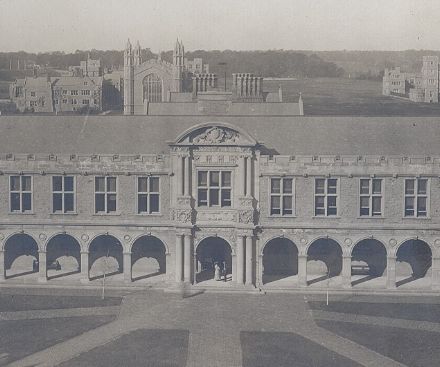
Missouri. A view of the quadrangle of Washington University in St. Louis, to be more precise. If you ask me, they should’ve implemented the 1925 plan to further develop the campus.
St. Vincent Ferrer
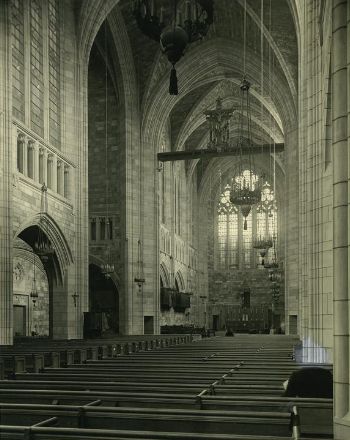
This photo shows the interior of the Dominican Church of St. Vincent Ferrer, designed by Goodhue, before it was fully completed. The stained glass has yet to be installed, and the same goes for the giant reredos which now graces the altar. A more current view is below.
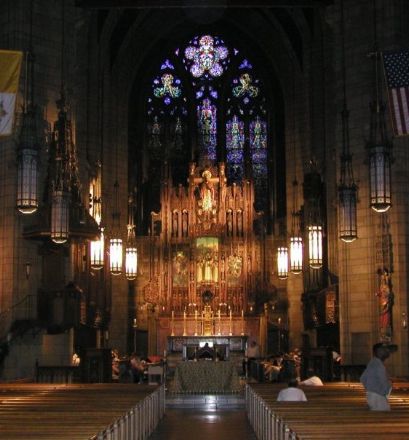
The Goodwin Mansion II
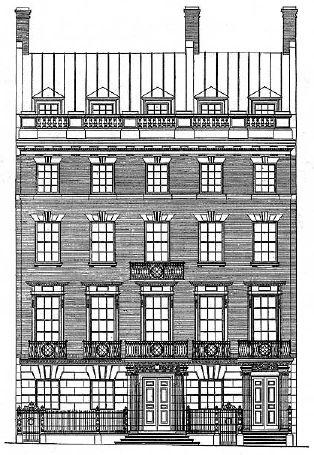
As an appendix to my previous post on the Goodwin mansion, I bring you an elevation of the facade (above) and the original plan of three of its floors (below).

Church of Christ the King, Gordon Square, London
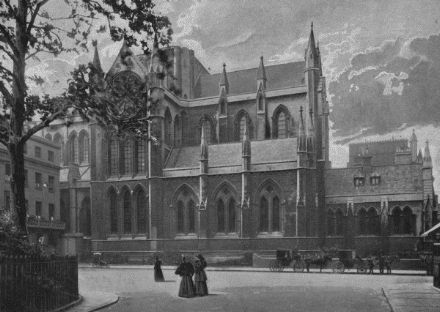
Though a comparitively small and minor sect, assiduous tithing by the members of Catholic Apostolic Church gave that group a number of stunning churches. (Their former church in Edinburgh was the subject of a previous posting).
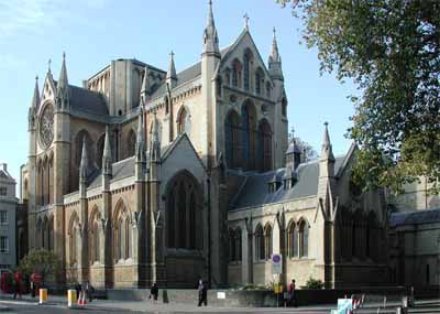
The building currently known as the Church of Christ the King on Gordon Square in Bloomsbury was constructed by the anachronistically-monikered Irvingites from 1853. The superb structure, built from Bath stone, is incomplete, lacking a few bays on the liturgical west of the building which kept the planned façade from being built. It also lacks a crossing tower, but then so does Westminster Abbey, the nave of which is only thirteen feet higher than that of Christ the King. (more…)
Scruton to America
 No sooner had I read in the Independent that the eminent philosopher Roger Scruton is moving to America than Mrs. Peperium sends me this article from the local paper about the historic home the Scrutons are moving into.
No sooner had I read in the Independent that the eminent philosopher Roger Scruton is moving to America than Mrs. Peperium sends me this article from the local paper about the historic home the Scrutons are moving into.
I am sure Professor Scruton, a keen huntsman, will enjoy the Virginia hunt country. In Britain, of course, the traditional English pasttime of foxhunting is illegal and thus the police must take time from fighting and preventing terrorism to try to enforce ridiculous class-warfare laws.
Dr. Scruton, America welcomes you with open arms!
Downside
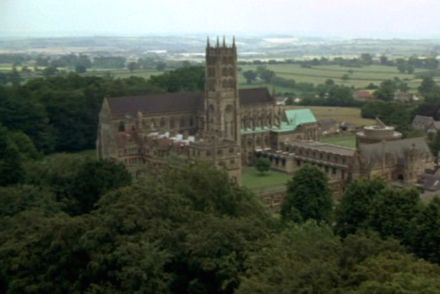
Last night I saw The Hole, a somewhat amusing ‘psychological thriller’ about a bunch of boarding school kids who lock themselves in an old bunker, have a party, then realise they can’t get out, yadda yadda yadda, people die. It was fairly light and worth watching if you’re easily entertained (and I often am). Perhaps the most enjoyable part was a few aerial shots of the Basilica of Saint Gregory the Great, Downside Abbey and School where our own Robert O’Brien will be teaching in the autumn. (The school was given a different name in the film).
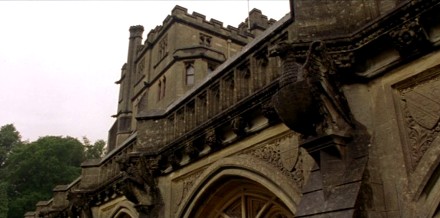
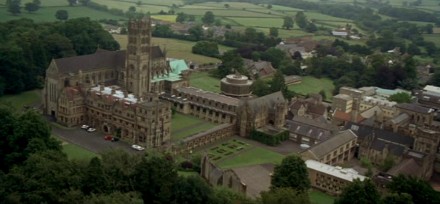

Films Recently Viewed
| The Life and Death of Colonel Blimp 1943 Directed by Michael Powell and Emeric Pressburger. A fine film, worth seeing. I’ve spied a few Blimps-in-training at the Mess in Wyvern. Also, Theo Kretschmar-Schuldorff is a heck of a good name for a character. |
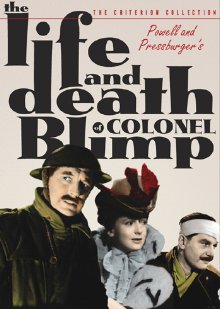 |
| La Grande Illusion 1937 Directed by Jean Renoir. I enjoyed this film greatly. It made me wish I had been a WWI pilot shot down by the Huns just so I could be invited to luncheon with the German officers. Everyone comported themselves well in those days (or at least in the cinema version of those days). According to IMDB, the Viennese Erich von Stroheim had spent so much time in America that he could barely speak German when the film was made. |
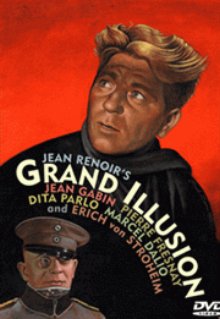
|
| The Birth of a Nation 1915 Directed by D.W. Griffith. Disturbing. The film’s basic premise that the United States was forged as a nation by the white knights of the Ku Klux Klan is balderdash, pure and simple. Still, a powerful and remarkable propaganda film. “It is like writing history with lightning, and my only regret is that it is all so terribly true,” said Woodrow Wilson, whose Southern racism most modern liberals like to ignore. |
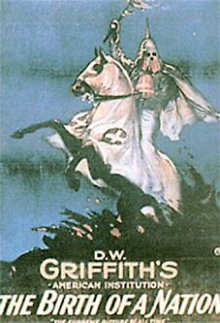
|
| Alexander Nevsky 1938 Directed by Sergei M. Eisenstein, score by Sergei Prokofiev. More brilliant propaganda, this time for the USSR, not the KKK. Beautifully shot, but the battle scene is a tad too long. Though very nationalistic, it is not hard to see the communism behind the film in a number of scenes. Found the only slightly veiled swastikas on the mitre of the Teutonic bishop rather droll. |
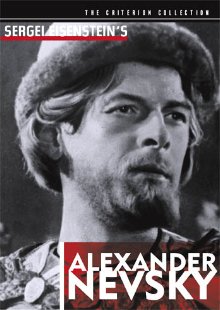
|
| The Battle of Algiers 1965 Directed by Gillo Pontecorvo, score by Ennio Morricone. My second viewing of this splendid film. Colonel Mathieu: “There are 80,000 Arabs in the Casbah. Are they all against us? We know they’re not. In reality, it’s only a small minority that dominates with terror and violence. That minority is our adversary; we must isolate it and destroy it.” And they did. Still managed to lose Algeria though – which was a damn shame for the Algerians. |
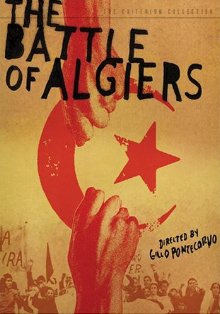
|
Chesterton Remembered
SIR: Your article on G.K. (This England, Summer 1986) brought back a happy personal memory of that great and kindly man. It was 1930 in Rome, where I was a pupil at a “finishing school” – in this case an English convent. G.K. sometimes came to visit our Reverend Mother; we knew him by sight and, once seen, who could forget the huge man in the big black cloak?
Part of our “finishing” process was to be taken round the museums and galleries of the Eternal City. One day we were being shepherded through the Vatican Museum. My friend and I somehow managed to get separated from the rest of our party and in one of the galleries whom should we see but Mr. G.K. Chesterton. He was about to leave so we followed him down the stairs in the hope of being able to get his autograph. At the foot of the stairs he turned. “As we had such young legs”, he said, “could one of us be so kind as to run back to the gallery where he had left his cloak, and would the other see if she could find him a carrozza [a cab, lit. ‘carriage’]?” We needed no second bidding. I raced back up the stairs, found the familiar black cloak where he had left it and triumphantly returned it to its owner. Meanwhile my friend had found a vacant carrozza. G.K. thanked us both, climbed into the carrozza and drove off. In the excitement we had forgotten about the autographs! Next day a letter arrived at our convent. He addressed it to “The Young Ladies suffering education at the convent at No. 10 Via Boncompagni.” Inside was a sheet full of auto-graphs and a little poem.
For you alone did I desire,
Who brought the prophet’s mantle down
And called his chariot of fire!
I have the precious autograph still and what a strange Chinese-looking affair it is!
— MRS. L. RIPLEY, BRIGHTON
The Old Irish Parliament House
Please see the updated article of the Irish Houses of Parliament, College Green, Dublin here.
Risen from the Ashes
by Austin Ruse
Sursum Corda, Summer 1998
The first wholly traditional Catholic parish structure built since Vatican II could not be situated in a more central location, at a more opportune time. New York is enjoying an astounding 1990s rejuvenation, bulging with tourists and new business. St. Agnes Church is at the center of it all, in midtown Manhattan, near Grand Central Station.
 Only at St. Agnes in New York City can an orthodox churchman be attacked from the right. Yet there they were, a dedicated band of angry young people picketing Msgr. Eugene V. Clark at Mass only one week after St. Agnes had burned nearly to the ground in late 1992. Their charge? That the good Monsignor intended to replace the old brick Gothic structure, now ruined, with what they called a “Swedish-Igloo-Modern.” Monsignor Clark never gets mad, but he got mad that day – although today he looks back on the incident with amusement. He even saved one of their flyers and is considering having it framed.
Only at St. Agnes in New York City can an orthodox churchman be attacked from the right. Yet there they were, a dedicated band of angry young people picketing Msgr. Eugene V. Clark at Mass only one week after St. Agnes had burned nearly to the ground in late 1992. Their charge? That the good Monsignor intended to replace the old brick Gothic structure, now ruined, with what they called a “Swedish-Igloo-Modern.” Monsignor Clark never gets mad, but he got mad that day – although today he looks back on the incident with amusement. He even saved one of their flyers and is considering having it framed.
Did those excitable young men and women actually live within the parish boundaries of St. Agnes? No. But then hardly anybody actually lives in the East 40s. St. Agnes has maybe 100 to 150 residential parishioners. Nobody really cares, either; and this is one of the charms of St. Agnes. It is a commuter church located next to one of the busiest ports of call in the world, Grand Central Station. St. Agnes Church is a place that is searched out, discovered, chosen. To many it seems that St. Agnes chooses them.
But there was that awful day when many thought it might close. (more…)
The Vicious Carbuncle of Brooklyn
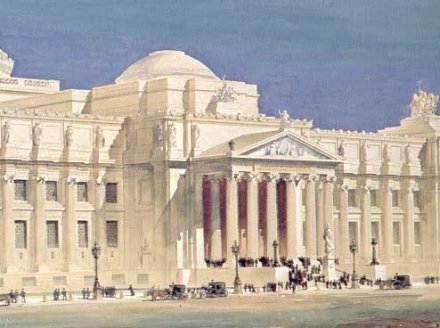
The Brooklyn Museum ought to be ashamed of itself. Though frequently overshadowed by its civic compatriot, the world-class Metropolitan Museum of Art in Central Park, this institution in Brooklyn’s Prospect Park is still considered one of the best museums in the United States. Its overall design was the work of the renowned McKim, Mead, and White who planned a sprawling beaux-arts palace for what was then known as the Brooklyn Insitute of Arts and Sciences. Their own illustration of the final design can be seen above and below (click the below image for a larger version). (more…)
Calatrava’s St. John the Divine
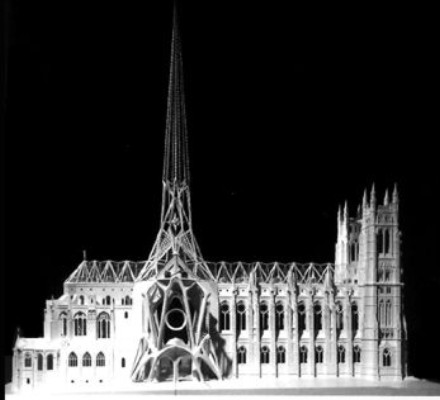
I’ve always somewhat admired Santiago Calatrava’s plan for the completion of the (Episcopalian) Cathedral of St. John the Divine here in New York. It was commissioned in the 1980’s by the über-dodgy Rev. James Parks Morton, dean of the Cathedral at the time. Morton was responsible for turning “St. John the Unfinished” into the hippie-trippy-ecumenical-syncretist-pagan-temple-cum-performing-arts-center it is known as today, and came up with this scheme to try to bring the cathedral to completion. (The plan has since been abandoned and all construction ceased a decade ago; scaffolding remains because the cost of removing it was judged to be too high).
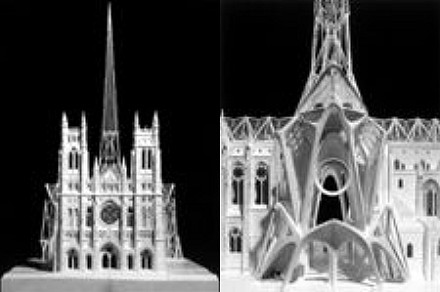
 The plan involved a ‘biosphere’ garden being planted atop the nave in the giant greenhouse formed by Calatrava’s lithely arches. Though I much prefer the crossing tower in the design by Ralph Adams Cram, I still think that Calatrava’s plan is rather exciting. It only succeeds, however, because Cram and (Heins & Lafarge before him) laid an ample beautiful foundation (well, obviously quite much more than that) for Calatrava to complete. The cathedrals which Signor Calatrava has designed completely himself have been completey devoid of aesthetic appeal, as well as conceived outside of the millenia-long tradition of church architecture.
The plan involved a ‘biosphere’ garden being planted atop the nave in the giant greenhouse formed by Calatrava’s lithely arches. Though I much prefer the crossing tower in the design by Ralph Adams Cram, I still think that Calatrava’s plan is rather exciting. It only succeeds, however, because Cram and (Heins & Lafarge before him) laid an ample beautiful foundation (well, obviously quite much more than that) for Calatrava to complete. The cathedrals which Signor Calatrava has designed completely himself have been completey devoid of aesthetic appeal, as well as conceived outside of the millenia-long tradition of church architecture.
The (Catholic) Diocese of Oakland commissioned Calatrava to design their new ‘Cathedral of Christ the Light’ after the old seat was greatly damaged in an earthquake. Despite the vacuousness of the design (model below), Signor Calatrava proved to be outside the Diocese’s budget, and his second-rate design was shelved and replaced with a third-rate design of a vaguely similar ilk. The third-rate design is the one which will be built, though a first-rate proposal in the vernacular style natural to California has been drawn up by Mr. Domiane Forte. Methinks Signor Calatrava should stick to his catchy bridges.
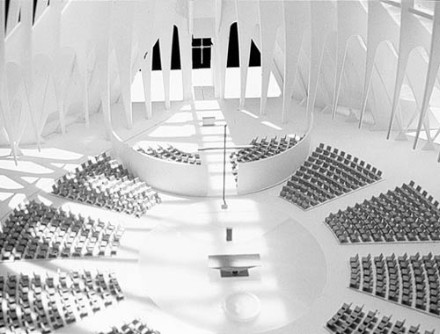
Brownson on the Scholar
St. Gregory’s, Brooklyn
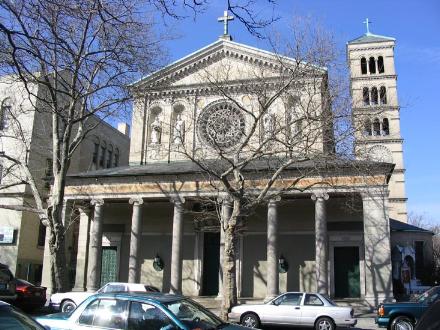
“St. Gregory’s Church of 1917, located at Brooklyn Avenue and St. John’s Place, was closely based on the ‘idealistic ground plan’ of St. Clement in Rome, an archetypal basilica with an open, colonnaded narthex and a tall engaged campanile on one side of the nave. In keeping with its prototype, St. Gregory’s was gaudily decorated with figural frescoes and mosaics.” – New York 1930
It seems a rather pulchritudinous church; I’ll have to add it to the list of places to visit. It was designed by Helmle and Corbett, who were also responsible for the Bush Tower, built a year later. The Bush Tower will soon get a brand new neighbor, seen below.

Top photo lifted from the ever-nifty Bridge and Tunnel Club‘s Walk Down Brooklyn Avenue.
Boldt Castle

Boldt Castle would have been among the finest homes in all New York had it ever been completed. The estate was started by Prussian immigrant and hotel entrepreneur George Boldt in the early 1900’s, and was intended to be presented to his wife Louise on St. Valentine’s Day. Tragically she died in 1904 before the castle was completed and work on the nearly-finished home stopped. The Boldts never returned to the island.
The small island estate is impressive nonetheless. It rests in the middle of the Saint Lawrence River on what was originally called Hemlock Island in the Thousand Islands region of New York. The island was renamed Hart Island when purchased by Congressman E.K. Hart, and upon being sold to the Boldts, the spelling was changed to Heart Island. (more…)
Rip van Winkle
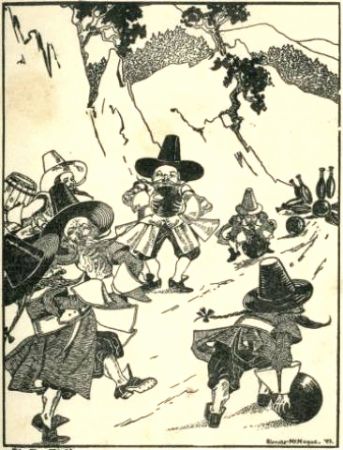
When was the last time you read the story of Rip van Winkle? If you’ve never had that pleasure, then you are all the worse for it, my friend. The tale was handed down to us through the ages by the munificence of one Diedrich Knickerbocker, though some sore-minded rapscallion later credited the ever-capable Washington Irving with its invention. Anyhow, it is one of my favorite tales in all the history of New York. It’s a short story, and worth a read online if you haven’t a printed copy immediately at hand.

The tale, of course, revolves around “a simple good-natured fellow”, namely Rip van Winkle, and his encounter with “odd-looking personages” whom still to this day show themselves around the Hudson valley. We merely have ceased to hear reports of them because thoroughly unimaginative types are in control of the world these days. (The “monotony monitors” as my Latin teacher monikered them, enforcing boredom and mediocrity at every possible opportunity).
The genealogists amongst you will be interested that Mr. Knickerbocker notes this van Winkle was “a descendant of the Van Winkles who figured so gallantly in the chivalrous days of Peter Stuyvesant, and accompanied him to the siege of Fort Christina.” Now, for want of fast-paced action, you may not have any particular desire to read about a simple, good-natured fellow like Rip van Winkle, but desires aside you must read “the Most Horrible Battle Ever Recorded in Poetry or Prose” (Chapter VII of Book VI of the same Diedrich Knickerbocker’s A history of New York, from the beginning of the world to the end of the Dutch Dynasty). The record of the siege of Swedish Fort Christina by the good New Netherlandish is the most hilarious and enchanting chronicle of any battle anywhere.
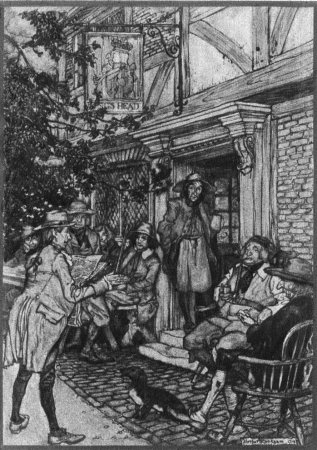
Search
Instagram: @andcusack
Click here for my Instagram photos.Most Recent Posts
- Amsterdam November 26, 2024
- Silver Jubilee November 21, 2024
- Articles of Note: 11 November 2024 November 11, 2024
- Why do you read? November 5, 2024
- India November 4, 2024
Most Recent Comments
- on The Catholic Apostolic Church, Edinburgh
- on Articles of Note: 11 November 2024
- on Articles of Note: 11 November 2024
- on Why do you read?
- on Why do you read?
- on University Nicknames in South Africa
- on The Situation at St Andrews
- on An Aldermanian Skyscraper
- on Equality
- on Rough Notes of Kinderhook
Book Wishlist
Monthly Archives
Categories


